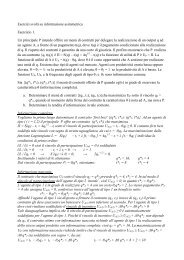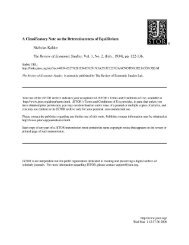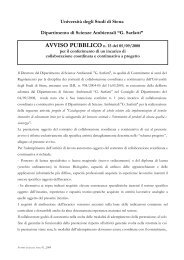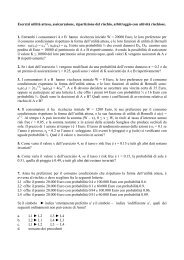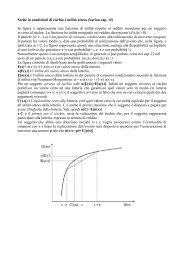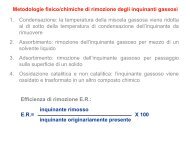Stabilisation Policy in a Closed Economy Author(s): A. W. Phillips ...
Stabilisation Policy in a Closed Economy Author(s): A. W. Phillips ...
Stabilisation Policy in a Closed Economy Author(s): A. W. Phillips ...
You also want an ePaper? Increase the reach of your titles
YUMPU automatically turns print PDFs into web optimized ePapers that Google loves.
294 THE ECONOMIC JOURNAL [JUNE<br />
correct<strong>in</strong>g action, by alter<strong>in</strong>g government expenditure, taxation,<br />
or monetary and credit conditions, <strong>in</strong> order to change demand <strong>in</strong><br />
a direction which tends to elim<strong>in</strong>ate the error. The amount by<br />
which aggregate demand would be changed as a direct result of,<br />
the stabilisation policy (i.e., exclud<strong>in</strong>g the further changes <strong>in</strong><br />
demand which will be <strong>in</strong>duced automatically through the operation-<br />
of the multiplier process) if the policy were to operate without<br />
time lag will be called the potential policy demand, and the<br />
amount by which aggregate demand is <strong>in</strong> fact changed at any<br />
time as a direct result of the policy will be called the actual<br />
policy demand. Both may, of course, be either positive or<br />
negative.<br />
The actual policy demand will usually be different from the<br />
potential policy demand, ow<strong>in</strong>g to the time required for observ<strong>in</strong>g<br />
changes <strong>in</strong> the error, adjust<strong>in</strong>g the correct<strong>in</strong>g action accord<strong>in</strong>gly<br />
and for the changes <strong>in</strong> the correct<strong>in</strong>g action to produce their full<br />
effects. A distributed time lag can aga<strong>in</strong> be <strong>in</strong>troduced by the<br />
hypothesis that whenever such a difference exists the actual<br />
policy demand will be chang<strong>in</strong>g <strong>in</strong> a direction which tends to<br />
elim<strong>in</strong>ate the difference and at a rate proportional to the difference.<br />
The time constant of this lag can then be def<strong>in</strong>ed <strong>in</strong> the same way<br />
as was done <strong>in</strong> the case of the production lag. The examples<br />
given below have been worked out for alternative correction lags<br />
with time constants of six months and six weeks respectively.<br />
A number of different types of stabilisation policy will now<br />
be considered, correspond<strong>in</strong>g to the different ways <strong>in</strong> which the<br />
correct<strong>in</strong>g action taken may be related to the error <strong>in</strong> production.'<br />
3. Proportional <strong>Stabilisation</strong> <strong>Policy</strong><br />
The simplest type of stabilisation policy is one <strong>in</strong> which thIe<br />
correct<strong>in</strong>g action taken is such that the potential policy demand<br />
is made proportional <strong>in</strong> magnitude and opposite <strong>in</strong> sign 2 to the<br />
error <strong>in</strong> production. The ratio of the potential policy demand to<br />
the error, which is a measure of the strength of the stabilisation<br />
policy, will be called the proportional correction factor. As an<br />
example, a proportional correction factor of 0.5 would mean that<br />
1 The follow<strong>in</strong>g treatment is an application of the general pr<strong>in</strong>ciples of<br />
automatic regulat<strong>in</strong>g systems and closed-loop control systems, <strong>in</strong> the analysis of<br />
which notable advances have been made <strong>in</strong> recent years. Cf. G. H. Farr<strong>in</strong>gton,<br />
Fundanmentals of Automatic Control, Chapman and Hall, London, 1951; and Brown<br />
and Campbell, Pr<strong>in</strong>ciples of Servomechanisms, John Wiley and Sons, New York,<br />
1948. On the use of closed-loop control theory <strong>in</strong> economics, cf. A. Tust<strong>in</strong>, The<br />
Mechanism of Economic Systems, He<strong>in</strong>emann, London, 1953.<br />
2 That is, the pr<strong>in</strong>ciple of " negative feed-back " is used.



